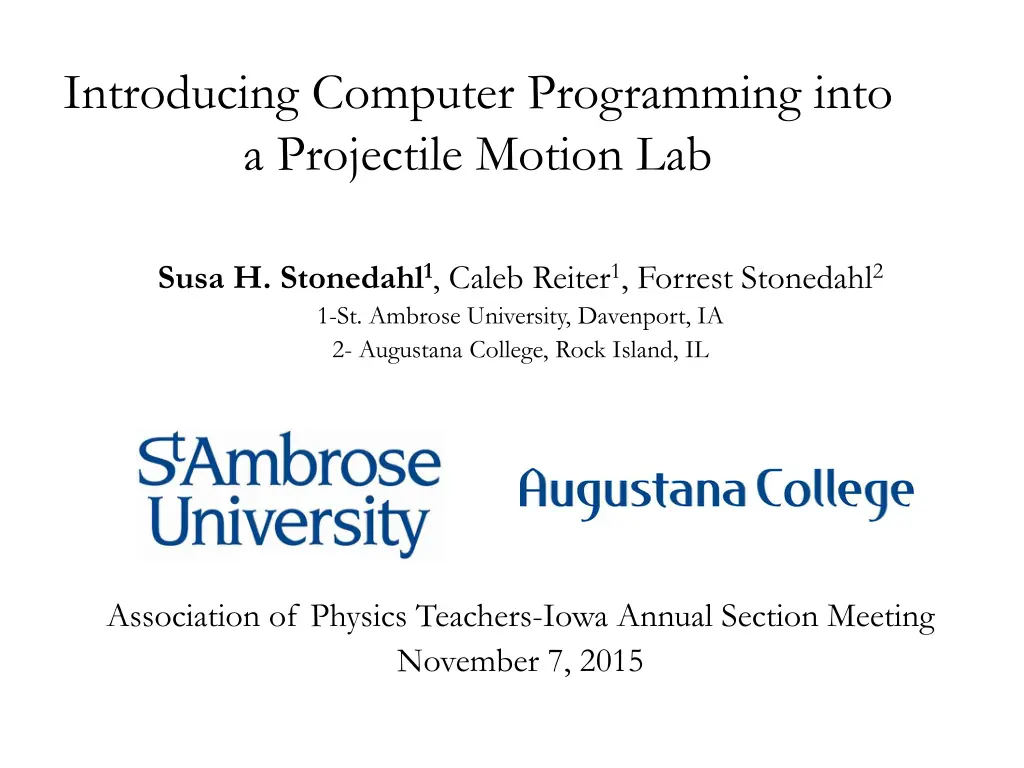
Integrating Computer Programming in Projectile Motion Lab
"Explore the integration of computer programming to enhance understanding of projectile motion in a lab setting. Learn how to calculate the x and y locations of a projectile's journey using kinematics with the aid of a computer for efficiency."
Download Presentation

Please find below an Image/Link to download the presentation.
The content on the website is provided AS IS for your information and personal use only. It may not be sold, licensed, or shared on other websites without obtaining consent from the author. If you encounter any issues during the download, it is possible that the publisher has removed the file from their server.
You are allowed to download the files provided on this website for personal or commercial use, subject to the condition that they are used lawfully. All files are the property of their respective owners.
The content on the website is provided AS IS for your information and personal use only. It may not be sold, licensed, or shared on other websites without obtaining consent from the author.
E N D
Presentation Transcript
Introducing Computer Programming into a Projectile Motion Lab Susa H. Stonedahl1, Caleb Reiter1, Forrest Stonedahl2 1-St. Ambrose University, Davenport, IA 2- Augustana College, Rock Island, IL Association of Physics Teachers-Iowa Annual Section Meeting November 7, 2015
Computer Programming is important! Scientists should all understand what computers can do for us. Computers save time. Allow us to calculate things we cannot calculate by hand. I ve experienced several good students who have wasted many hours doing something simple that could have been done quickly with a computer.
Projectile Motion Lab Situation: A projectile is fired from the ground at a specified velocity (magnitude and direction) in an air resistance free world. Use the computer to: Calculate the x and y location of its journey at MANY times using kinematics until it returns to the ground.
ax=0 ay=-9.8
Set initial velocity: Magnitude Direction They will change these values!
Find velocity components ?? ???= ??sin( ) ???= ??cos
MATLAB works in radians mode, so we have to convert from degrees to radians. 180?= ?
How long until the projectile hits the ground? ? = ?0? + 1/2??2 0= (?0+ 1/2?t)t 0= ?0+ 1/2?t dy=0 ay=-9.8 v0y=known t=goal -2?0/? =t
Define all the times: 0, 0.01, 0.02, 0.03, 0.04 .time_max
Make lists of xs and ys each with the same number of slots as t.
For Loop: The index ii varies from 1 to the number of time values ? = ?0? + 1/2??2
Students are asked to vary the initial velocitys magnitude: Vo=100 Vo=50
Students then read the maximum displacements from the graph And use kinematics to solve for both displacements!
Students then change time_step to 1 second And use 5 different initial angles:
Counting the dots approximates the time. (Number of dots is the rounded down value of the time.) And use kinematics to find the times!
Ive shown you the MATLAB program for this exercise. My co-authors converted my code into Python, which is a very similar language. (Python is freely available for download) The MATLAB code, Python code, and lab exercise are available for download at: http://susa.stonedahl.com/teaching.html#proj_ motion_comp_lab
Ive shown you the MATLAB program for this exercise. My co-authors converted my code into Python, which is a very similar language. (Python is freely available for download) Questions? The MATLAB code, Python code, and lab exercise are available for download at: http://susa.stonedahl.com/teaching.html#proj_ motion_comp_lab
